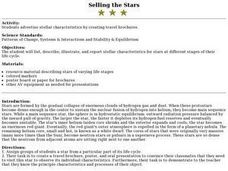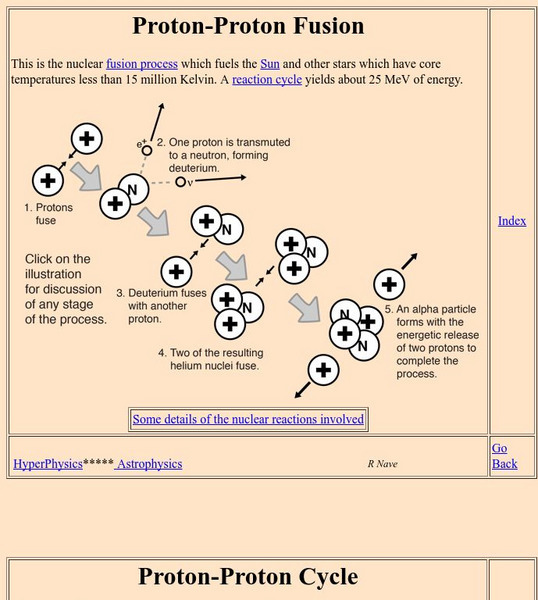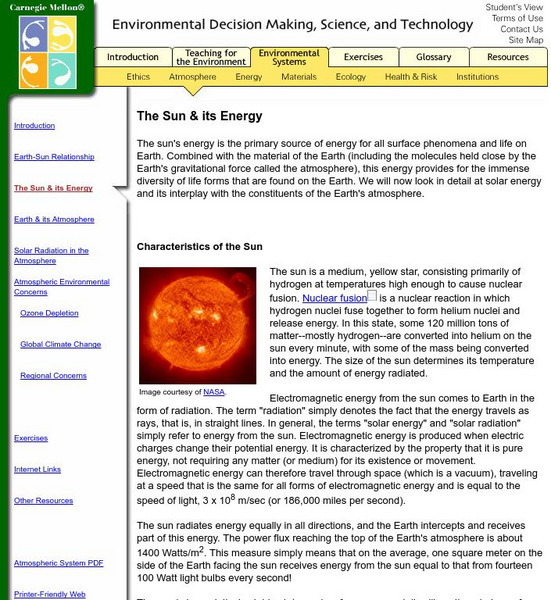Curated OER
Solar S'Mores
Students investigate solar energy. In this solar energy lesson, students compare how heat is absorbed in light-colored objects and dark-colored objects by making S'mores.
Curated OER
Selling the Stars
Students create a travel brochure, poster, and presentation to encourage others to visit a star. In this stellar characteristics lesson, students research a star type based on its life-cycle. They create a travel campaign to convince...
Curated OER
Conservation of Energy
In this energy learning exercise, students read about the Law of Conservation of Energy and compare the 6 forms of energy. Then students complete 20 matching, 2 short answer, and 6 word problems.
Curated OER
Timing An X-ray Pulsar
Students use X-ray data to identify an object as a rotating neutron star, and determine its period of rotation. They use XTE observations of the Crab Pulsar to determine the period of the light intensity, interpret this period as the...
Curated OER
Lives of Stars
Students take notes on the lives of stars. In this lesson on stars, students take notes alongside a PowerPoint presentation about the lives of stars.
Texas State Energy Conservation Office
Unit 2 - Section 2 - Fuels for Everything
In this alternative energy activity, 6th graders read and study the varying types of fuel. Students read examples and ways that alternative fuel can be used.
Curated OER
Conservation of Energy
In this energy instructional activity, students review the law of conservation of energy and how energy is transformed from one form to another. Students complete 10 matching, 10 fill in the blank, and 7 problems to solve.
Atomic Archive
Atomic Archive: Nuclear Fusion
From the Atomic Archive - the online companion to the award-winning CD-ROM. This page defines nuclear fusion and depicts the process by an informative diagram. Includes numerical values which describe the typical energy values for fusion...
NASA
Nasa: The Sun's Energy Source
This site, which is provided by NASA, gives some scientific history and a clear and detailed explanation of nulcear forces and nuclear fusion.
Georgia State University
Georgia State University: Hyper Physics: Proton Proton Fusion
A look at the reaction that fuels the Sun with this diagram of the nuclear fusion process.
NASA
Nasa: Space Place: Play Helios: A Game About How the Sun Makes Energy!
In this pairing game, keep the Sun shining bright by matching up particles. Convert hydrogen atoms into helium atoms. This process is called nuclear fusion.
Nine Planets
The Eight Planets: The Sun Solar Wind
This Eight Planets site briefly describes solar wind, a low density stream of charged particles emitted by the Sun. It also provides the basics on the sun's composition and additional sun links.
NASA
Nasa Star Child: The Sun
Get to know our nearest star with this introduction to the sun. Listen to the information in an audio file. Vocabulary words are linked to a glossary of terms. Features include links to other interesting facts and a printable version of...
CK-12 Foundation
Ck 12: Earth Science: Interior of the Sun
Identify the layers of the Sun's interior. [Free Registration/Login may be required to access all resource tools.]
CK-12 Foundation
Ck 12: Earth Science: Outer Layers of the Sun
Identify the outer layers of the sun. [Free Registration/Login may be required to access all resource tools.]
CK-12 Foundation
Ck 12: Earth Science: Interior of the Sun
[Free Registration/Login may be required to access all resource tools.] Identify the layers of the sun's internal structure.
CK-12 Foundation
Ck 12: Earth Science: Sun
[Free Registration/Login may be required to access all resource tools.] Provides an introduction of the sun's basic properties.
Other
University of Leicester: Sun
Provides a brief overview of the Sun, including a focus on solar eclipses, solar wind, and solar sailing.
Carnegie Mellon University
Telstar: The Sun and Its Energy
The sun's energy is the primary source of energy for all surface phenomena and life on Earth. Combined with the material of the Earth (including the molecules held close by the Earth's gravitational force called the atmosphere), this...
Carnegie Mellon University
The Sun and Its Energy
The sun's energy is the primary source of energy for all surface phenomena and life on Earth. Combined with the material of the Earth (including the molecules held close by the Earth's gravitational force called the atmosphere), this...
Encyclopedia of Earth
Encyclopedia of Earth: Solar Radiation
Almost all of the energy that drives the various systems (climate systems, ecosystems, hydrologic systems, etc.) found on the Earth originates from the sun. Solar energy is created at the core of the sun when hydrogen atoms are fused...
PBS
Pbs Learning Media: Birth of a Supernova, Type Ii
In this interactive activity from NOVA Online, learn about a type of exploding star a Type II supernova that is so large it has a mass 10 times greater than the mass of our Sun.
NASA
Nasa Star Child: Stars
This page details the life cycle of a star, and includes information on medium-sized and massive stars, plus a glossary and a question.
NASA
Nasa Star Child: Star Child
StarChild from NASA defines and describes the Solar System in a simple and easy-to-understand manner. The website is broken down into two versions for the student, grade school and junior high.






















